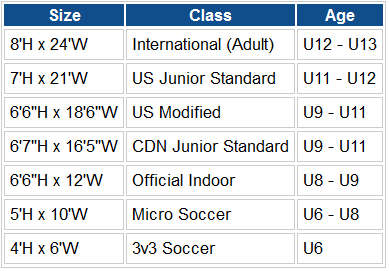Soccer is indeed one of the easiest games on earth, thanks to its non-complicated nature. You don’t have to be sports genius to play soccer, although some different soccer skills are required for scoring the game.
With 90 minutes of given time (excluding extras), the utmost attention is always given towards the goals rather than the players themselves.
Few Know The Actual Goal Size
Talking about the goals, what more is important than a goal score in the game of soccer? Many people however, do not really know the dimensions of a soccer goal, as to how things are placed or how this would determine the validity of a goal.

The standard goal dimensions
Basic Example
A simple example for you is on foul, which happens when a goal score is attained in a fouled manner. It’s a violation of the game, and if a goal score is entered, it may be rendered void.
The question here is; what determines this positioning of foul? The answer’s quite simple; the dimensions of the goal and the areas around.
The Most Common Size
Let’s start from the goal itself. Technically, the goal post is 2.44 metres (8 feet) tall and 7.32 metres (24 feet) long for professional games, and its gets smaller by levels.
Next is the goal line, which refers to the line that a team is attempting to advance the ball towards, normally the end of the soccer pitch area.
Between the two is where the whole excitement of the game lies, surrounded by several different dimensions which would determine a valid goal.
All of these dimensions are provided by the standard rule derived from Law 1 of the 17 Laws of the Game called “The Field of Play”.
For the goal itself, apart from its size, its location also matters. The goals are located at the centre of each goal-line, and a valid goal comes in when the ball crosses the goal line between the goal posts.
Even if a defending player had interrupted the course of the ball before it had entered, it would still amount as a goal, provided that the laws were properly followed by the player, and no offence was committed in the eyes of the referee.
Goal Area
Off the hook, the most important area in a successful goal score is the goal area, which surrounds the goal.
The area is practically confined within lines that start 5.5 metres (6 yards) from the goal posts extending 5.5 metres (6 yards) into the pitch from the goal line, with another line joining the two.
A valid goal, be it a free kick or a short-length goal may be taken from within this area.
This goal area is in turn surrounded by the penalty area, which begin 16.5 metres (18 yards) from the goal posts and extend 16.5 metres (18 yards) into the field, with the lines parallel to the goal area.
This box is extremely important to determine foul play which would finish up for the opposing team for a free kick by way of a penalty kick from the penalty spot or mark; a spot located directly in the middle and in front of the goal, attached to the penalty area.
Different Levels
Now coming back to the dimensions of a soccer goal, this is basically determined according different levels as mentioned above, same soccer rules applying to the pitch as well.
Youth Sizes
Youth soccer goals are normally 4.5 feet high by 9 feet wide, and middle school soccer goals are normally 6.5 feet high by 18 feet wide.
High School
For high school goals, the dimensions would be the same as to the professional soccer goal size above, correspondingly as to the pitch dimensions.
Unexpectedly, college soccer goals are slightly smaller than high school ones at 7 feet high by 21 feet wide.
Summary
The size of the soccer goal depends of course what competitiong you are playing at and how old you are.

